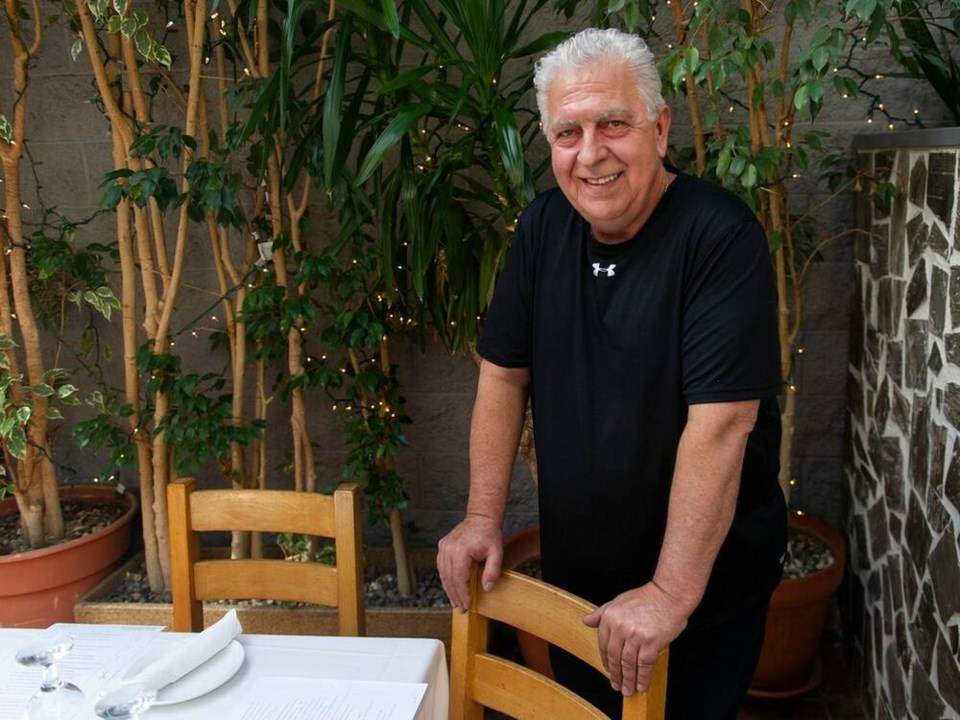It’s a late Monday afternoon, traditionally slow in the restaurant business, but already a smattering of customers occupy tables at Mythos Taverna in North 91原创, not bad for 45 minutes after opening at 4 p.m.
Mythos, a charming and popular mom-and-pop fixture in North Van, has a devoted and loyal fan base and held its own during COVID-19. Itis owned and operated by Nick Fikeris and his wife, Poppy — he cooks, she greets.
“Actually we’ve been OK, I’d say we’re almost back to [pre-COVID] normal,” Nick Fikeris said. “But I think we are an exception, you have to look at the whole picture. I’ve heard a lot of stories from suppliers and the industry is suffering.”
The numbers back him up and aren’t reassuring.
Many restaurants don’t open until late afternoon now and even at some places there’s a lineup to get in, a quarter or third of the tables could be sitting vacant because there’s not enough staff. And anyone has had a bite out of late knows appetizers can now cost what a main cost in 2019.
Post-pandemic challenges include inflation the likes of which haven’t been seen in decades, COVID-related debt, supply-chain problems, labour shortages, rising taxes, more red tape and the switch to delivery apps, said Mark von Schellwitz, vice-president of Western Canada with Restaurants Canada.
“It’s resulted in the worst industry profitability in history,” he said. “I was actually shocked by the number of restaurants that are losing money or just breaking even but still not making a profit.
“There’s a fourfold increase in the number of unprofitable restaurants.”
Between polling companies such as Angus Reid and Circana, federal resources such as Statistics Canada and the minimum wage database, and its own in-house surveys, Restaurants Canada found food sales at the province’s 15,000 restaurants have almost but still not quite reached 2019 levels. Those restaurants did $17.7 billion in sales last year: Full-service restaurants make up 49 per cent of the membership, fast-food joints 37 per cent and the remaining are made up of caterers and such.
Add that 45 per cent of the workforce now works from home most of the time, thereby making a lot more of their own lunches, the B.C. minimum wage has risen more than twice as much as the consumer price index since 2015 and those government emergency loans, known as CEBA, are coming due.
“It’s a perfect storm,” von Schellwitz said.
Finally, the apps: pre-COVID, pickups and deliveries at full-service restaurants accounted for 20 per cent of sales; now it’s twice that.
Dine-delivery means customers don’t come in, sit down, relax with drinks and perhaps be enticed by a server into having specials and dessert, but customers do pay a hefty premium to have their food and, should they choose, booze, delivered.
“Takeout is the least-profitable part of food service sales,” von Schellwitz said. “But customers want it and while restaurants might not make money on the apps it gives them much-needed cash flow just to pay their bills and keep stock moving.”
Most independent restaurateurs, understandably, detest the dine-delivery apps.
“It don’t like them, but I have them and I don’t lose money on them,” Fikeris said. “But they cost people about 25 per cent more than if they’d eaten here.
“I tell people on the phone if they come here for pickup they save almost 25 per cent. But for a lot of people [dinner delivery] is a big convenience.”



